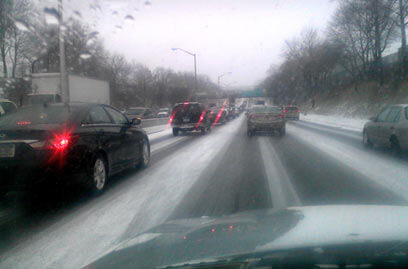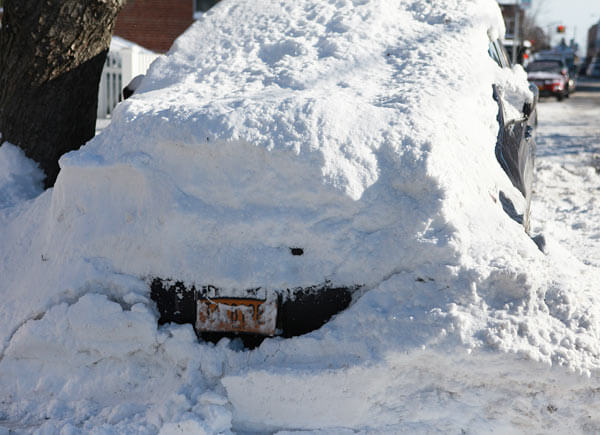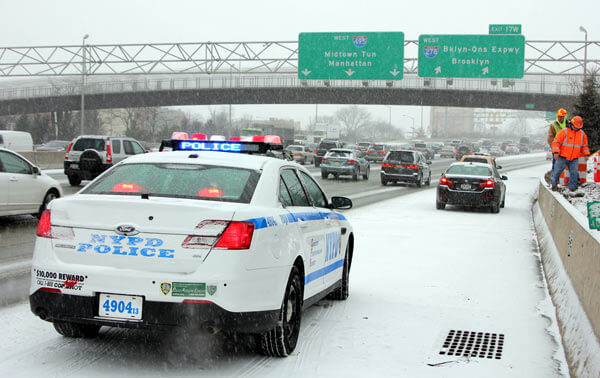By TimesLedger staff
Residents in some parts of Queens were faced with more than a foot of snow Wednesday morning after another round of winter weather made its way through the area, leaving behind freezing temperatures that are projected to last until the end of the week.
The National Weather Service reported that snow started coming down between 9 a.m. and 10 a.m. Tuesday and left several Queens neighborhoods with double-digit snowfall totals by the time the storm finished. South Ozone Park recorded 13 inches of snow by 12:30 a.m. Wednesday, while Fresh Meadows had more than 10 inches by late Tuesday night. Northeast Queens also recorded heavy totals as Whitestone received 8 inches before 8 p.m. Tuesday and Bayside was measured at 10.5 inches early Wednesday morning.
Heavy snow and ice created dangerous road conditions across much of the city and caused some public transportation to suffer delays. The Metropolitan Transportation Authority began encouraging straphangers Tuesday afternoon to head home early and avoid further travel if possible.
“Service on railroads, subways and buses can be curtailed or suspended entirely or on a route-by-route basis depending on snowfall accumulation,” the agency warned on its website.
In order to free up transit workers to help with snow removal and cleanup, the MTA cancelled its Fastrack work on the Queens Boulevard lines for the remainder of the week.
After the Tuesday evening rush hour, the Long Island Rail Road began running reduced service on a weekend schedule beginning around 8 p.m.
On Wednesday the transit system reported several delays, including on the No. 7 line, the LIRR’s Montauk and Port Washington lines and the QM1 and QM25 express buses between Glen Oaks and Manhattan.
The Port Authority said more than 500 flights in and out of John F. Kennedy International and LaGuardia airports were canceled Tuesday and Wednesday due to weather conditions, but both airports were operating close to schedule by Wednesday afternoon with delays of no longer than 15 minutes.
Weather stations at both New York airports also recorded sub-zero temperatures, with wind chills still as low as minus-15 degrees by early Wednesday. The weather service issued a statement around 5:30 a.m. warning of “bitter cold and below zero wind chills” that could last into Friday morning.
The city had not opened warming centers for the storm, but has doubled its homeless outreach to deal with frigid temperatures, said Christopher Miller, a spokesman for the city Office of Emergency Management.
“We’re not opening warming centers, but looking at other measures that will effectively get people out of the cold and their heat and hot water turned on,” he said.
The city provides emergency heating assistance to low-income New Yorkers who find themselves without heat. Residents, who could receive fuel delivery or boiler repair once a year during frigid temperatures, should call 311 to see if they are eligible.
OEM also released tips for staying warm throughout the storm, including wearing lots of extra layers outside and keeping fingertips, earlobes and noses covered to protect against hypothermia and frostbite.
Despite the snow and cold, New York City public schools opened Wednesday, a decision Mayor Bill de Blasio defended during a news conference held Wednesday to address the storm.
“When I heard from the National Weather Service at 10 p.m. that [the snow] was tapering off rapidly, I recall the consensus that we could get the system to work effectively,” he said. “You always start with the assumption that you’d rather have school as long as it’s safe. Closing school is a very big deal and it has a lot of ramifications.”
The city Department of Homeless Services instituted Code Blue procedures, which are designed to protect those without shelter when temperatures plummet.
When in effect, DHS doubles its outreach efforts to assist homeless New Yorkers and provides shelter to any family or individual, regardless of whether they formally qualify for housing.
Lisa Black, assistant commissioner of government and community relations for DHS, said the department had 12 vans searching for homeless people instead of the usual five or six.
As the storm set in Tuesday, she said the 311 line fielded 27 calls about homeless individuals, up from the typical 10 to 12 on any given winter night.
“The public is really the best information source we have on days like this,” Black said.
On Jan. 21, 51,649 individuals stayed in shelters compared to 51,371 people last Friday.



































